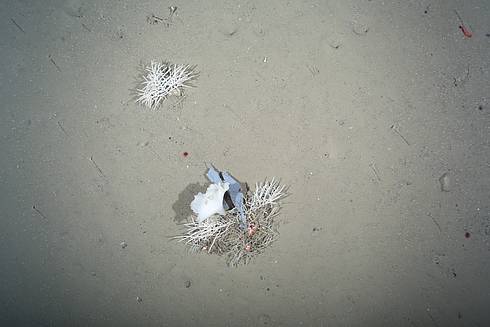The Arctic has a serious litter problem: in just ten years, the concentration of marine litter at a deep-sea station in the Arctic Ocean has risen 20-fold. This was recently reported in a study by Mine B. Tekman, Thomas Krumpen & Melanie Bergmann, researchers at the Alfred Wegener Institute, Helmholtz Centre for Polar and Marine Research (AWI).
Plastic bags, glass shards and fishing nets: despite its location, far from any urban areas, the amount of litter in the depths of the Arctic Ocean continues to rise, posing a serious threat to its fragile ecosystem. Since 2002, AWI researchers have been documenting the amount of litter at two stations of the AWI’s “Hausgarten”, a deep-sea observatory network, which comprises 21 stations in the Fram Strait, between Greenland and Svalbard.
“Our time series confirms that litter levels in the Arctic deep sea have risen rapidly in the past few years,” says first author and AWI biologist Mine Tekman.
The scientists involved in the study observed the ocean floor at a depth of 2,500 metres using the OFOS (Ocean Floor Observation System), a towed camera system. Since the start of their measurements, they have spotted 89 pieces of litter in a total of 7,058 photographs. To enable comparison with other studies, the researchers have extrapolated the litter density to a larger area. The result: an average of 3,485 pieces of litter per square kilometre in the monitoring period (2002 to 2014). Further, there has been a clearly recognizable increase in the past few years: when the team calculated a contamination level of 4,959 pieces of litter per square kilometre for 2011 in an earlier study, they hoped it was a statistical outlier. But the levels have continued to rise since, reaching a new peak of 6,333 pieces of litter per square kilometre in 2014.
The situation is particularly dramatic at the network’s northern station, called N3.
“Here the amount of litter rose more than 20-fold between 2004 and 2014,” says Tekman.
If we consider the findings for the northern research area in the marginal ice zone, the data for 2004 indicated 346 pieces of litter per square kilometre. Ten years later, the number had risen to 8,082. The level of contamination is similar to one of the highest litter densities ever reported from the deep seafloor, in Cap de Creus Canyon off the eastern coast of the Iberian Peninsula.
Among the litter they photographed, the researchers observed plastic and glass most frequently. As a rule, glass does not drift; it sinks straight down to the ocean floor. This indicates local sources and concurs with increasing ship traffic in the region due to the receding ice. Still, it is extremely difficult to draw any firm conclusions on the origin of the plastic litter, since it often covers a considerable distance before reaching the seafloor. In most cases, the scientists can’t determine the origin on the basis of photographs alone. While it is clear that the Gulf Stream transports plastic litter into the Arctic with the Atlantic water masses, the authors also have a new theory as to why litter is accumulating in the Fram Strait: their results indicate a positive relationship between litter density and the summertime expansion of sea ice.
“If we’re right, sea ice could entrain floating litter during ice formation. During warmer periods, the ice breaks up and is transported to the south into the Fram Strait with the Transpolar Drift, releasing entrained litter into the survey area when it melts,” says deep-sea biologist Dr Melanie Bergmann, a co-author of the study.
“To date we’ve assumed just the opposite, since we viewed the ice as a barrier to litter contamination.”
The researchers are still faced with the puzzle of when and how plastic litter changes on its way to the deep sea. Over time they have observed more and more small bits of plastic, which are likely the result of larger pieces of litter fragmenting and could point to an increasing level of microplastic. This is surprising, since in the deep sea there is no UV light to break down the plastic, and the low temperatures are not conducive to disintegration. In the summer of 2016 the team rediscovered a piece of plastic, which they had first seen two years earlier. Bergmann:
“Running into this same piece of plastic twice with hardly any changes to it is a vivid reminder that the depths of the Arctic are at risk of becoming a depot for plastic litter. The well-hidden accumulation of litter on the deep ocean floor could also explain why we still don’t know where 99% of the marine plastic litter ends up.”
You may read the report herebelow
Source: AWI































































